«I could do non-alienated work, I never had any money, but I also never had any financial straits.»
Jihad Mansour [Marc Rudin]
Extracts from a correspondence with Marc Rudin on his cooperation with Palestinian Liberation Organisations from 1979 through 1991.
Tell me something about the problems and contradictions you had to cope with doing visual artwork in the context of a war of liberation, but also about your everyday life as a commercial artist in countries of the periphery (Trikont).
To start with I'll
tell you how I came about designing posters in the first place: In 1975
/ 76 I was working with a group of painters in Milano. We were painting
large-formated graffiti on the walls of squat-houses and on naked walls
of the district Porta Ticinese. At the time I was paying visits to Palestinian
comrades who were living in Italy. We talked about my work and they proposed
that I should design posters for the Palestinian resistance movement.
I was full of enthusiasm and by the end of September I reached the port
of Saida by trawler as the airport was closed at the end of the civil
war.
I was given a small room on the rooftop terrace of a building seven stories
high. I had nothing more than bits of paper (sometimes just the reverse
pages of old posters) and some felt pens to work with. It was shortly
before the fall of Tal al Za'atar. So I was first asked to design a poster
that should have the title: Tal al Za'atar, symbol of the antifascist
resistance. A Kalashnikov gun was standing in a corner of my room. I picked
it up, had a look at it and I knew I had a topic for my first poster.
While working I had to evacuate from the building all the time because
the terrace was exposed to incessant shelling. The fascinating bit of
my work was that the distance between myself and the people I was working
for was much smaller than it had been in Europe. I also became aware in
a more direct way whether they appreciated my work or not. The feedback
was rather straight and made no detours.
The lino-cutter and anti-fascist Oement Moreau, after twelve years of exile in Argentine, came under pressure by the take-over of Peron. He wrote in 1947 /48: «I was working a lot during these years. I have also learned a lot and I'm standing here like a tree bearing ripe fruit with nobody to pluck them.» You have also been working and learning a lot during the twelve years of your exile. On your tree have also grown a lot of good fruit. But I think because of your close cooperation with the Popular Front for the Liberation of Palestine (PFLP) your situation in exile was easier than it has been for Moreau, who was working as a free lancer. The fruit of your work has been plucked by the Palestinian comrades. Have you been paid for?
They paid the rent of the room I was working and living in. Whenever I was ill, I was looked after as well. I never had to pay any doctor or medicine. I was also provided with material for my work. Very often there were enough good clothes that came from the collections of used clothes in Europe. On top of it I received a very small salary like all those working for the cause. It was more like a pocket-money, just enough to pay for food and transportation. We were living on very little like everyone else in the camps. We adapted our needs to those of our neighbours. Somehow we were happy to have partly escaped the western pressures of a materialistic society. We were doing well. I could do non-alienated work, I never had any money, but I also never had any financial straits.
It seems to me that this was a very beautiful and conscious sort of cooperation, full of solidarity. In Western Europe we don't know it that way. Posters are designed free of charges like any other engagement in leftist groups and movements; nothing against that of course. We are used to earn our living from other sources, which is a lot more easy over here anyway. But sometimes I think that this kind of work is not taken for being worth very much -because it is done for free. But anyway, when you were living in Bern, Paris or Bienne, you had to earn a living which meant constant interruptions, disturbances and diversions while working on a poster. In Beirut or Damascus instead you were able to fully concentrate on an idea and work it out. You were not the only graphic artist in the organisation: Who decided who would do the incoming jobs?
Usually we decided collectively at the beginning of the year for which events and anniversaries we wished to produce posters. We also discussed other ongoing projects like the designing of calendar leaves. This work was distributed among all of us. During the year there had also to be done the posters that were responding to actual events. These posters were drawn by those who had an idea on the topic at the time.
Tell me something
about the productive process of a particular poster, for instance the
one you've designed for Labour Day 1984), Palestinian workers - avant-garde
of the revolution, which shows a working man with a wrench in his hand
in front of a red flag.
On the left we can see his face in profile as well as the Kuffiya; the
poster itself is almost filled with bis «strong arm» (all the wheels have
stopped turning) and its extension through the wrench. The point of it
is the shadow of the wrench on the red flag in the form of a Kalashnikov
barrel. This slight friction of natural laws intends to remind watchers
that the armed struggle has to be linked inseparably to the struggle of
the proletarian masses, if it should not end in defeat. How did you stumble
on this topic and how did you work it out?
In the peripheral countries (Trikont) the industrial working class has not been developped to such an extent as for example in the newly emerging economies. Therefore Labour Day is not yet playing such an important role for the masses. Marxist avantgardes have got to propagate it as a link between the national struggle for liberation and proletarian internationalism. Because I was raised in an industrialized country this was my job to do. I was also showing more interest in the topic than the others did (perhaps out of old memories or sentimentality, who knows?). Most of the time the idea for a poster crossed my mind while I was walking through town or sitting in cab. Visual impressions may have played a role in it as well. I remember that for this particular poster I was relying on a speech of Habash wherein he was condemning the division of labour and also bureaucratization. With regard to Palestinians he was also speaking against the division of labour between the people, fighters and intellectuals i.e. Not only in times of general mobilization, like in 1982, people working in offices were sent to serve in the army. It was called revolutionary service. This aspect of the lifting of the division of labour became the topic I started working on. With regard to Labour Day I wished to have lots of red colours. The deep green in the background should stand for fertile Palestine. The Kuffiya as a symbol had to be there as well because I was not designing a poster for Labour Day in Bern. In the centre we see the arm of the working man, the wrench as part of the point.
How did you carry on?
Even before I put a pencil on the paper I developped the idea of doing the poster in two colours in order to save costs. In 1976 I had done sketches of landscapes with different felt pens in Italy. Mixing three colours on the paper I was able to create new shades and casts. That's how I came about drawing the poster simply with a red and a green felt pen without the special material of a graphic illustrator. When I had it all together I started drawing lots of rough drafts, sometimes even more than fifty, most of them with a ballpoint pen in the format of postcards or even smaller. I tried to outline the composition: how can I express all the things I wish to say, so that it becomes perfectly clear and nothing is lost. The small format of the draft is very important, because a poster very often is watched from the distance. You are forced to concentrate on essential parts. With this particular poster a horizontal format became imminent as it was supporting the forward movement. When the rough copies were done I started drawing sketches in colour in the format of 35cm x 25cm, which was a quarter of the size of the poster.
Did you show these sketches to the others to make sure they were seeing the same things as you did?
I gave them the coloured drafts. The people I was working with gave me a free hand. They were open to new things. That's why I had little problems carrying my points through. The Labour Day poster was accepted on the spot. On the basis of the coloured draft I also discussed technical aspects with the reprographic photographer who saw no problems emerging with the material he had at hand. Then I finished the poster in the original format of 70cm x 50cm.
At this stage you essentially changed the initial composition: On the
coloured draft, the working man steps into sight from the right holding
a hammer. The position of the arm is some what clumsier...
A driver of the office was posing for the «strong arm». He had been a fighter for a long time and years later he would still point at the poster in the office saying, «my arm». An anatomic model only helps you not to go to far astray. I let him pose only for a quarter of an hour maybe. Then I had to concentrate again on the realization of the main subject. For other compositions I used mirrors to check on anatomic details. This happend mostly at home in a quiet athmosphere. When the poster was ready I went to the person in charge of the information unit. He would think of a suitable text that had to be translated into English as well. Very often it was quite a hustle to get these texts.
Pardon? You didn't design a poster according to a given text but exactly the other way round?
Sometimes I would
have liked to have a slogan first, it would have been much easier. I could
also have prevented a certain routine and repetitions. The problem was
that we had to be creative every year for the same anniversaries without
being repetitive. There were only a few occasions when I was able to work
according to a given text. For the poster, we are talking about, I thought
that only a handwritten lettering would do, which I did myself (even in
the arabic alphabet).
The poster is from the time when the PFLP and the DFLP formed the «Democratic
Alliance» and tried to unite the marxist forces amongst the Palestinians.
They also tried to bring together information work which manifests itself
through the signature of the poster. The «Demo-cratic Alliance» got frozen
later on by the DFLP unilaterally because it wished to come closer to
the bourgeois tendencies in the PLO around Arafat.
How long did it take from the idea of the poster's topic to it's final composition?
The posters had to be printed at least two weeks in advance, because they often had to be shipped to Europe, Asia, Africa or Latin-America. As the printing shops were not always reliable enough I tried to deliver the composition as early as possible. Once I was working on a poster over the period of three months, always making pauses in between. But sometimes it became a nervous pushing and shoving when we had to react to actual events. The longer I was there, the longer it took me to design posters. This was due to the fact that I became more critical towards the problems and had to go further and further searching for new outlooks. I can remember that I designed the Labour Day poster during one week towards the end of March. The production itself was less efficient than in Europe. In the camp I lived were hardly any phones. So if I had to arrange a detail with the printer, or something like it, I had to run around a lot, be it only to get an offer. But I got used to this rhythm and I got to like it as well.
The poster reminds me strikingly of how close it still stands to our common
outset. Its completely stripped of any pathos, bare of any overloaden
symbolism. You used simple signs taken from everyday life and the worker
isn't just a posing body-builder but a simple worker. He seems self-confident
enough to be in the streets with a red flag on Labour Day. Whether he
realizes the shadow he is throwing remains unclear: The shadow can be
seen as standing for the function of the worker as a historical subject,
or as a human being, who must not explicitly have realized yet, what he
could be able to achieve. Perhaps your comrades would have liked better
to see other compositions, as for example the worker in the middle of
the poster looking straight forward and filling the whole size of the
format, thus symbolizing the dynamics of the masses instead of the hidden
entanglements of the individual? It is obvious that people from different
cultures have different points of view.
Of course I had to learn a lot of things, as the symbols or even the symbolic aspects of colours for instance differ from one culture to another. In 1980 I designed a poster for Labour Day with dominant green colours. I was harshly criticized by a young fighter that green was the colour of Islam and that we were no fundamentalists. In his opinion the colour of green had therefore nothing to do on a Labour Day poster, a fact I had not taken into account with my cultural background.
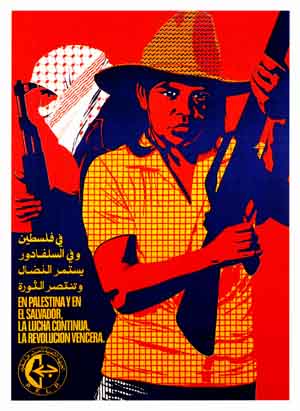
The struggle goes on in Palestine and in Salvador, and the Revolution will be Victorious [Poster 1981]
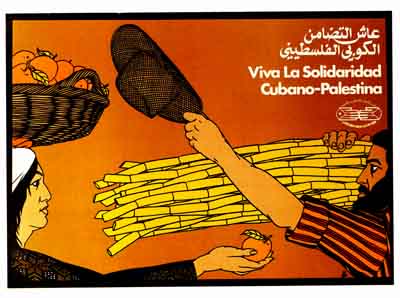
Long Live the Cuban-Palestinian Solidarity [Poster 1990]
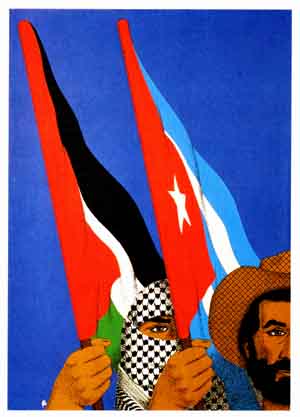
Long Live the Friendship between the peoples of Palestine and Cuba
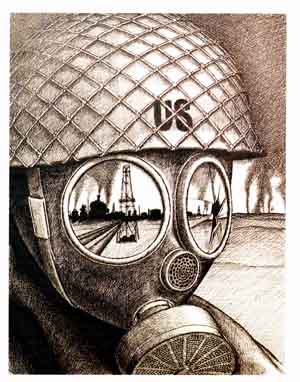
U.S.: Out of the Golf [July/ August 1990]
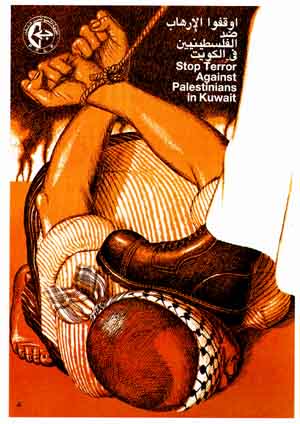
Stop the Terror against Palestinians in Kuwait [1991]
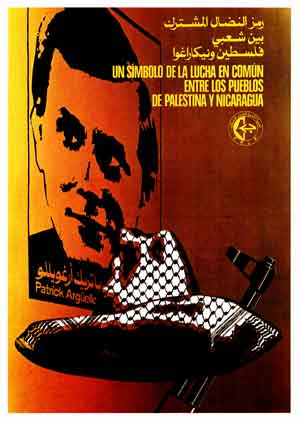
Patrick Arguello, a Symbol for the Common struggle of the Palestinian and the Nicaraguan People [1981]
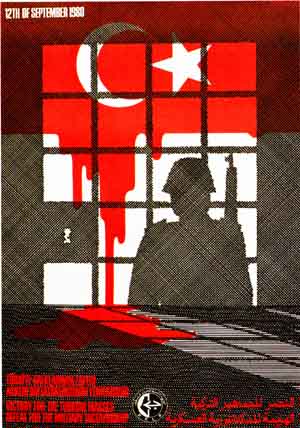
12 th September 1980 Victory for Turkish Masses - Defeat for the Military Dictatorship
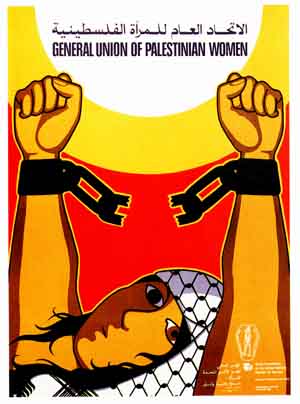
General Union of Palestinian Women / World Conference of the United Nations. Decade for Women - Equality, Development and Peace, 1980
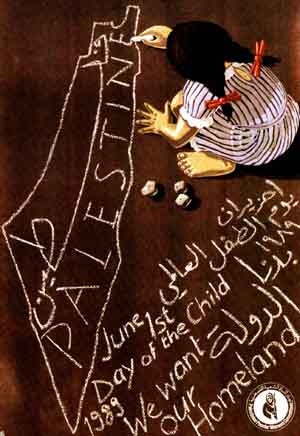
June 1th - Day of the Child We Want Our Homeland - Palestine [June 1989]
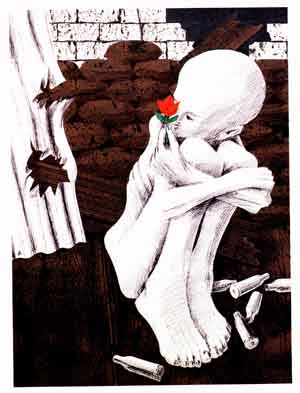
Starving the Camp Will Not Halt Palestinian Resistance [March 1987]
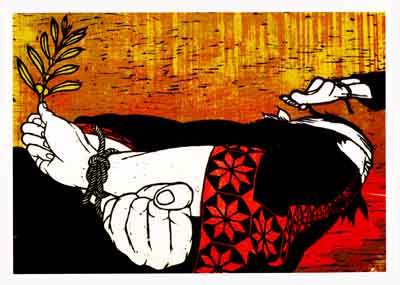
Woodcut Commemorating the September Massacres against Palestitians: Massacres Can`t Stop the Dawn of Indepence [Oct. 1989]
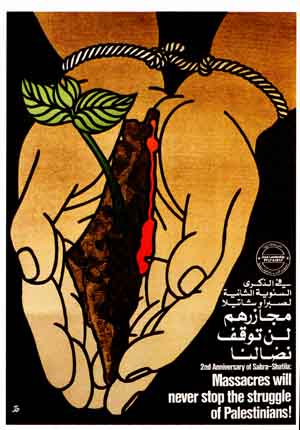
Second Anniversary of the Sabra-Shatila Massacre - Massacres will never stop the Struggle of The Palestinians [Sept. 1984]
